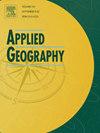Achieving a balance between supply and demand for urban cultural infrastructure: A case study of Nanjing, China
IF 5.4
2区 地球科学
Q1 GEOGRAPHY
引用次数: 0
Abstract
Cultural infrastructure (CI) is an essential part of urban infrastructure and serves as a significant conduit for urban culture. Its optimal development is essential for enhancing the functionality of cultural services and advancing the construction of urban ecological civilization. This study, using Nanjing as a case in point, employs spatial analysis methods to explore the spatial disparity between CI supply and demand. This was accomplished by calculating the relative values of supply and demand and by employing pattern-optimized zoning. The results indicate that Nanjing generally possesses a commendable CI per capita, although the quantity and per capita amount of each type vary significantly across different administrative districts. CI is mainly located in the economically developed downtown area as well as the political and cultural centers of the counties surrounding Nanjing. Approximately 20.15 % of residential areas exhibit an imbalance between CI supply and demand. Pattern optimization can be categorized into three types of zones: advantage displaying, new construction, and balanced construction, with 12.09 % necessitating targeted optimization.
实现城市文化基础设施的供需平衡——以南京市为例
文化基础设施是城市基础设施的重要组成部分,是城市文化传播的重要渠道。优化发展,对增强文化服务功能、推进城市生态文明建设具有重要意义。本研究以南京市为例,运用空间分析的方法,探讨了CI供需的空间差异。这是通过计算供需的相对价值和采用模式优化分区来实现的。结果表明,南京市的人均CI总体上处于较高水平,但不同行政区域的CI数量和人均CI金额存在较大差异。CI主要位于经济发达的市区以及南京周边县域的政治文化中心。大约20.15%的住宅区域出现了CI供需失衡。格局优化可分为优势彰显区、新建区和均衡区三个区域,其中12.09%需要进行针对性优化。
本文章由计算机程序翻译,如有差异,请以英文原文为准。
求助全文
约1分钟内获得全文
求助全文
来源期刊

Applied Geography
GEOGRAPHY-
CiteScore
8.00
自引率
2.00%
发文量
134
期刊介绍:
Applied Geography is a journal devoted to the publication of research which utilizes geographic approaches (human, physical, nature-society and GIScience) to resolve human problems that have a spatial dimension. These problems may be related to the assessment, management and allocation of the world physical and/or human resources. The underlying rationale of the journal is that only through a clear understanding of the relevant societal, physical, and coupled natural-humans systems can we resolve such problems. Papers are invited on any theme involving the application of geographical theory and methodology in the resolution of human problems.
 求助内容:
求助内容: 应助结果提醒方式:
应助结果提醒方式:


